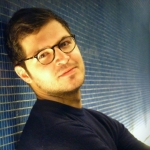The white coffin of Genoa
Genoa -- When news broke that part of the A10 highway bridge had collapsed in Genoa, I knew exactly which one it was. Although I never knew the Morandi Bridge by its name, I’ve driven on it countless times, on the way to visit my mother’s family in a village north of Naples. I was always struck by how the behemoth cut its way through the rooftops of the city.
After the alert of the collapse landed on Tuesday, August 14th, I did what I usually do as part of the social media team at the agency’s Paris headquarters -- I began scouring online for photos and videos of the disaster. It didn’t take long to find one that gave you shivers “Oh dio, oh dio!” (“Oh my God, Oh my God”) screamed one man as he videotaped with his cell phone a part of the bridge collapsing in the pouring rain.
Meanwhile the AFP machine went into its usual breaking news mode of organizing reporters, photographers and video journalists to head to the place of the accident.
One videographer from Rome hopped on the first train to Genoa. Another headed there from Bregancon in France, where she had been covering the vacationing French president. A photographer and a text stringer left from Nice, along with a photographer stringer from Milan. Rome’s chief photographer was on vacation, but managed to find a local shooter -- a friend of his wife’s cousin -- to send the first images that we had of the collapse.
At Paris headquarters, staffing was down to its usual August bare minimum -- offices in France empty out during the month as the country grinds to a holidaying halt. Finding Italian speakers to cover the accident was no easy task. Then one of the editors remembered that I’m half Italian and asked me whether I’d be interested in
going.
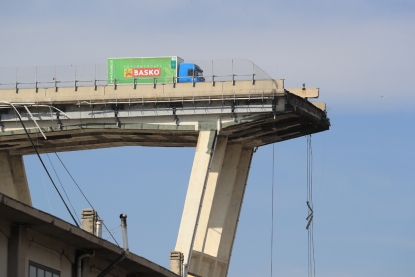 A lorry sits on the Morandi motorway bridge after it collapsed in Genoa on August 14, 2018.
(AFP / Valery Hache)
A lorry sits on the Morandi motorway bridge after it collapsed in Genoa on August 14, 2018.
(AFP / Valery Hache)A short while after that, I turned off my computer and headed out of the building with two notebooks, three black pens and a tape recorder. A quick detour by my apartment to pick up some clothes and water my basil plant and then to the airport for the 1720 flight to Genoa. Exactly five hours after the first alert of the disaster landed on the wire.
During our family trips, I had always been struck by just how big the Morandi Bridge was. And it’s just one of the numerous bridges and tunnels dissecting the city. Seen from a car, Genoa looks like an urban beast that has been pinned in place, caught between the mountains and the sea, by the bridges.
In a disaster this this, the job of a reporter is to gather the stories of people affected by the disaster. The tales vary from the heart-wrenchingly tragic to the heart-warmingly insignificant. But they touch you all.
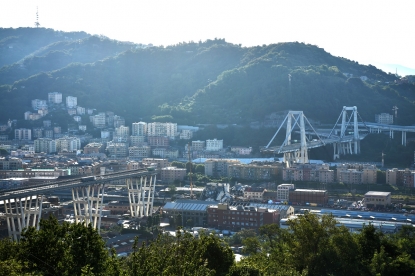 This general view taken on August 15, 2018, shows abandoned vehicles on the Morandi motorway bridge after a section collapsed in the northwestern Italian city of Genoa. (AFP / Piero Cruciatti)
This general view taken on August 15, 2018, shows abandoned vehicles on the Morandi motorway bridge after a section collapsed in the northwestern Italian city of Genoa. (AFP / Piero Cruciatti)The first and only time I cry during the trip -- the first time that I've ever cried while on a reporting assignment -- is on my last day in the city. Funeral day.
It’s Saturday, a day of mourning in the city. The funerals take place in an exposition parc that on this occasion assumes the air of a cathedral.
A man dressed in gray passes by me, clutching a wooden frame with a photograph of a smiling man inside. No doubt one of the 43 victims of the “cursed bridge.”
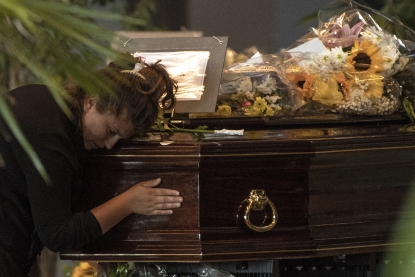 (AFP / Marco Bertorello)
(AFP / Marco Bertorello)A couple have come to say goodbye to a childhood friend. “He was working under the bridge when it collapsed,” the woman says. “That day was supposed to be his day off. But since the weather was bad, he decided to go to work, saying he’d take a day off when it was nice out.”
Thousands of people fill the hall by 11:30. Some are relatives. Others don’t know anyone who has died, but have simply come to pay respects to the victims.
The coffins are made from dark wood and are lined up in a row. One is placed apart, in front of the others. It’s white and it’s smaller than the others. It’s the coffin of eight-year-old Samuele, who died with her parents as they headed to vacation in Sardinia.
 (AFP / Piero Cruciatti)
(AFP / Piero Cruciatti)In all, three children and one teen died in the bridge collapse. The day before, a firefighter told reporters how he broke down in tears when he found a teddy bear in one of the cars crushed by the rubble.
The ceremony starts. The organ begins to play, the singers sing, the Genoa archbishop begins the mass, the smell of incense fills the space and it is then that I begin to cry.
During my four days I didn’t see any of the bodies of the victims and I’m glad I didn’t. Our Nice-based photographer, Valery Hache, saw them on Tuesday, hours after the accident, when he and other journalists approached the site of the disaster following the mayor’s car. He said he was shocked. Valery covered the Nice attacks in 2016, when bodies were literally lying in the street, so if he was shocked by the scene under the bridge, I am certainly glad that I didn’t witness it.
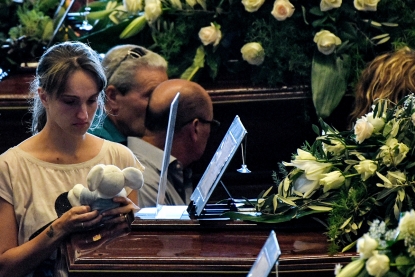 (AFP / Piero Cruciatti)
(AFP / Piero Cruciatti)I did witness the quiet grace of the people who had escaped death in the disaster.
Like Majid Alaoui, who was evacuated from his apartment under the bridge along with 630 other residents of the Sampierdarena neighborhood. Now he, his wife and their four-year-old daughter are sharing a small hotel
room.
“They say we’ll have to be here until November,” he tells me before quickly adding “But there are others worse off.” Like their neighbors in the hotel -- the family of a man who had died in the collapse who had come for his funeral.
Some of the evacuees are allowed to return to their homes quite quickly. On Thursday evening, we are waiting at the entrance of four buildings that had been deemed safe when a man approaches, carrying plastic bags in his hands. Francesco Formichella is one of the first people to come back. “I am a bit overwhelmed,” the 68-year-old tells us. “I am one of the oldest residents on this street. I was born here, in this very building.” His voice is taut with emotion.
 A view onto the Morandi bridge from an apartment in the city a day after the collapse.
(AFP / Piero Cruciatti)
A view onto the Morandi bridge from an apartment in the city a day after the collapse.
(AFP / Piero Cruciatti)Jacopo Strumia is emotional for another reason. He lives below another viaduc that slices through the city in the north. This bridge is nearly twice as high as Morandi. Dozens of families live below it. Some of the pastel-colored buildings are five stories high, but they seem infinitely small below such an infinitely gigantic structure.
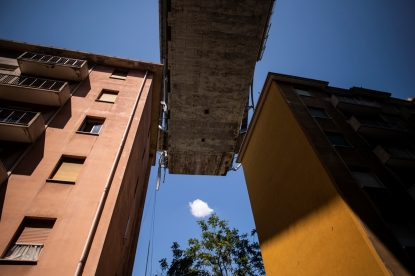 Appartment buildings are seen under the Morandi motorway bridge, two days after a section collapsed in Genoa on August 16, 2018.
(AFP / Marco Bertorello)
Appartment buildings are seen under the Morandi motorway bridge, two days after a section collapsed in Genoa on August 16, 2018.
(AFP / Marco Bertorello)Strumia is 29 and lives in a ground floor apartment. The Morandi collapse was a wake-up call for the father of two. He was already contemplating moving, but “after the tragedy it’s not going to be easy” to sell his apartment.
There is one story that I stumble upon that seems insignificant when compared with the pain and suffering inflicted on so many in the city. But it touches me nonetheless.
On Wednesday morning, I see an elderly man, standing with arms crossed and whistling down a street the leads toward the collapsed section of the bridge, a street that has been closed off by the police.
I ask him if he lives there. “No, I’ve come to give the kittens something to eat, but they won’t let me pass.” A few weeks ago, an alley cat gave birth to four kittens in a garden shed that he owns down the street. So ever since, he has come there every day to feed them, making the six-kilometer round trip journey on his bicycle.
The problem is that the shed is just 200 meters from the rubble of the bridge. The police won’t let him pass because it’s too dangerous. “They haven’t had anything to eat since Monday night, I don’t know if they’re alive or dead,” the man says, worried.
Eventually one of the policemen agrees to walk him to the shed and back. They reappear ten minutes later. I’ve forgotten my glasses in Paris but squinting, I can see their smiles from a distance. “They’re alive!" he yells to me. "They were starving, they ate everything.!”
A tiny, welcome happy ending in a city of grief.
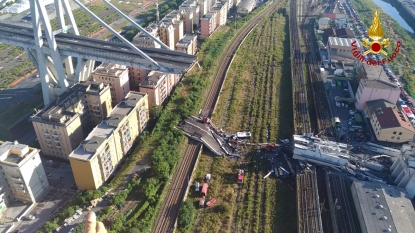 This handout picture taken and released by the Vigili del Fuoco, the Italian fire and rescue service, on August 15, 2018, shows rescuers at work amid rubble and wreckage after the collapse of a section of the Morandi motorway bridge in Genoa.
(AFP / Handout/Vigili del Fuoco)
This handout picture taken and released by the Vigili del Fuoco, the Italian fire and rescue service, on August 15, 2018, shows rescuers at work amid rubble and wreckage after the collapse of a section of the Morandi motorway bridge in Genoa.
(AFP / Handout/Vigili del Fuoco)


